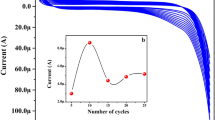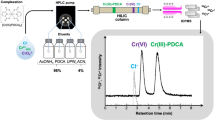Abstract
4,13-Didecyl-1,7,10,16-tetraoxa-4,13-diazacyclooctadecane (kryptofix22DD) has been explored as a neutral ionophore for preparing polyvinyl chloride (PVC)-based membrane sensor selective to lead(II). The optimized membrane incorporating kryptofix22DD as the active material, nitrobenzene as plasticizer and sodium tetraphenylborate as an anion excluder and membrane modifier in PVC (in the weight ratio of 5.0: 63.0: 2.0: 30.0, respectively) was directly coated on the surface of graphite rod. The sensor exhibits a Nernstian slope (29.4 mV/decade) in the concentration range of 1.0 × 10–5 to 1.0 × 10–1 M Pb2+. The detection limit of the sensor is 6.5 × 10–6 M. The proposed sensor has a fast response time (~10 s), a satisfactory reproducibility and relatively long lifetime. The electrode shows high selectivity toward Pb2+ ion in comparison to other common cations. The proposed sensor is suitable for use in aqueous solutions in a wide pH range of 2.0–10.0. It was used as an indicator electrode for the end point detection in the potentiometric titration of Pb2+ ion with ethylenediaminetetraacetic acid (EDTA) and sodium iodide (NaI) solutions. The proposed sensor was successfully applied for the recovery of Pb2+ ions spiked in real water samples.
Similar content being viewed by others
References
D. Ammann, W. E. Morf, P. Anker et al., Ion-Sel. Electrode Rev. 5, 3 (1983).
M. E. Mayerhoff and M. N. Opdycke, Adv. Clin. Chem. 26, 1 (1986).
S. Li-Xian, T. Okada, J. P. Collin, and H. Sugihara, Anal. Chim. Acta 329, 57 (1996).
A. Kumar and S. K. Mittal, Sens. Actuators B 99, 340 (2004).
A. K. Singh and S. Mehtab, Sens. Actuators B 123, 429 (2007).
A. K. Singh and S. Mehtab, Talanta 74, 806 (2008).
B. H. Freitas, F. A. Amaral, N. Bocchi, and M. F. S. Teixeira, Electrochim. Acta 55, 5659 (2010).
F. Bakhtiarzadeh and S. Ab Ghani, J. Electroanal. Chem. 624, 139 (2008).
G. H. Rounaghi, R. Mohammad Zadeh Kakhki, and H. Sadeghian, Electrochim. Acta 56, 9756 (2011).
A. Ghaemi, H. Tavakkoli, and T. Mombeni, Mater. Sci. Eng. C 38, 186 (2014).
R C. Gracia and W. R. Snodgrass, Am. J. Health Syst. Pharm. 64, 45 (2007).
L. Patrick, Altern. Med. Rev. 11, 2 (2006).
N. C. Papanikolaou, E. G. Hatzidaki, S. Belivanis, et al. Med. Sci. Monit. 11, 329 (2005).
C. C. Su, M. C. Chang, and L. K. Liu, Anal. Chim. Acta 432, 261 (2001).
S. Sadeghi, G. R. Dashti, and M. Shamsipur, Sens. Actuators B 81, 223 (2002).
A. Michalska, M. Wojciechowski, E. Bulska, et al., Talanta 79, 1247 (2009).
I. Ion, A. Culetu, J. Costa, et al., Desalination 259, 38 (2010).
D. Wilson, M. de los Angeles Arada, S. Alegret, and M. del Valle, J. Hazard. Mater. 181, 140 (2010).
X. J. Yuan, R. Y. Wang, C. B. Mao, et al., Inorg. Chem. Commun. 15, 29 (2012).
F. Faridbod, M. R. Ganjali, R. Dinarvand, et al., Sensors 8, 1645 (2008).
S. Buoen, J. Dale, P. Groth, and J. Krane, J. Chem. Soc., Chem. Commun. 20, 1172 (1982).
R. D. Nobel and J. D. Way, Liquid Membranes: Theory and Applications (American Chemical Society, Washington, DC, 1987).
H. Tsukube, Liquid Membranes: Chemical Applications (CRC Press, Boca Raton, FL, 1990).
G. W. Gokel, Crown Ethers and Cryptands (The Royal Society of Chemistry, London, 1991).
H. Tsukube, K. Yamashita, T. Iwachido, and M. Zenki, J. Org. Chem. 56, 268 (1991).
M. Hiraoka, Crown Ethers and Analogous Compounds (Elsevier, Amsterdam, 1992).
M. R. Ganjali, H.A. Zamani, P. Norouzi, et al., Bull. Korean Chem. Soc. 26, 579 (2005).
M. R. Ganjali, M. Tahami, M. Shamsipur, et al., Electroanalysis 15, 1038 (2003).
M. R. Ganjali, A. Daftari, P. Nourozi, and M. Salavati-Niasari, Anal. Lett. 36, 1511 (2003).
M. R. Ganjali, L. Hajiagha-Babaei, A. Badiei, et al., Anal. Sci. 20, 725 (2004).
Genplot, A Data Analysis and Graphical Plotting Program for Scientist and Engineers. Computer Graphic Service (Ltd., Ithaca, New York, USA, 1989).
G. H. Rounaghi, Z. Eshaghi, and E. Ghiamati, Talanta 44, 275 (1997).
E. Bakker, P. Büuhlmann, and E. Pretsch, Electroanalysis 11, 915 (1999).
M. A. Arada Pérez, L. Pérez Marín, J. C. Quintana, and M. Yazdani-Pedram, Sens. Actuators B 89, 262 (2003).
P. Buhlmann, E. Pretsch, and E. Bakker, Chem. Rev. 98, 1593 (1998).
D. Ammann, E. Pretsch, W. Simom, E. Lindner, et al., Anal. Chim. Acta 171, 119 (1985).
T. Rosatzin, E. Bakker, K. Suzuki, and W. Simon, Anal. Chim. Acta 280, 197 (1993).
Y. Umezawa, P. Buhlmann, K. Umezawa, et al., Pure. Appl. Chem. 72, 1851 (2000).
A. K. Jain, A. K. Singh, S. Mehtab, and P. Saxena, Anal. Chim. Acta 551, 45 (2005).
Author information
Authors and Affiliations
Corresponding author
Additional information
The article is published in the original.
Rights and permissions
About this article
Cite this article
Banuti, A.G., Ghaemi, A. Highly Selective Lead(II) Coated Graphite Sensor Based on 4,13-Didecyl-1,7,10,16-tetraoxa-4,13- diazacyclooctadecane as a Neutral Ionophore. Russ. J. Inorg. Chem. 63, 89–97 (2018). https://doi.org/10.1134/S0036023618010023
Received:
Published:
Issue Date:
DOI: https://doi.org/10.1134/S0036023618010023




